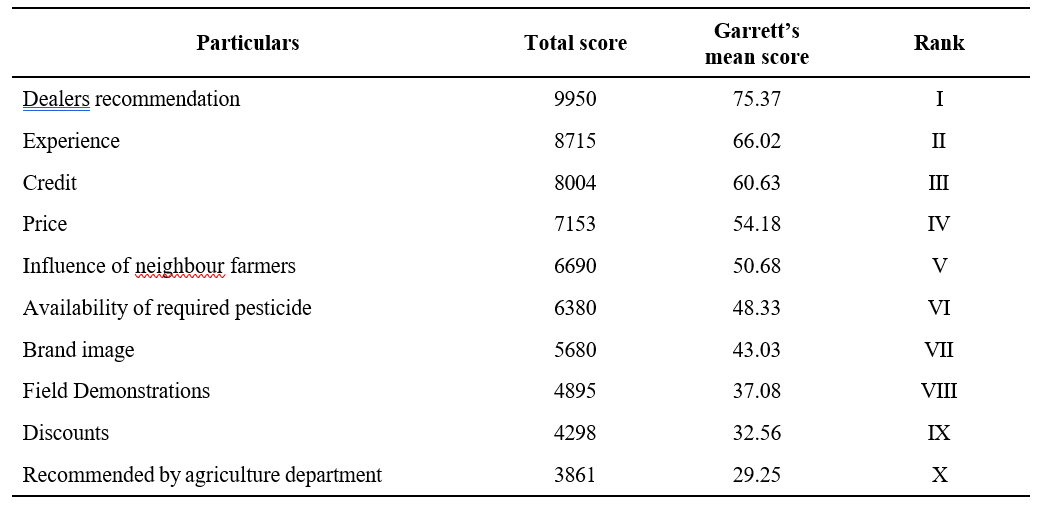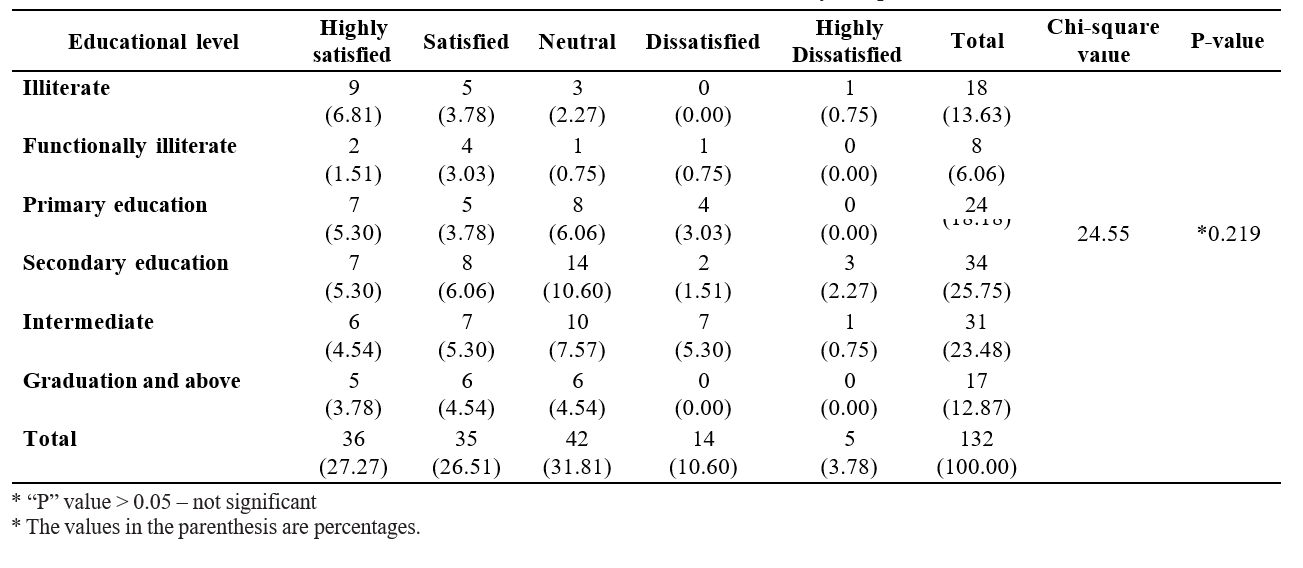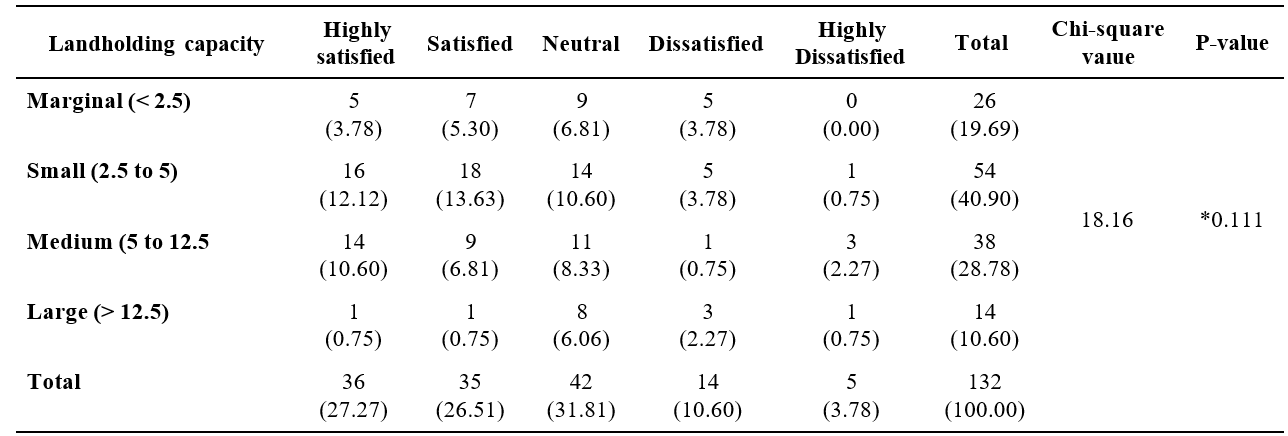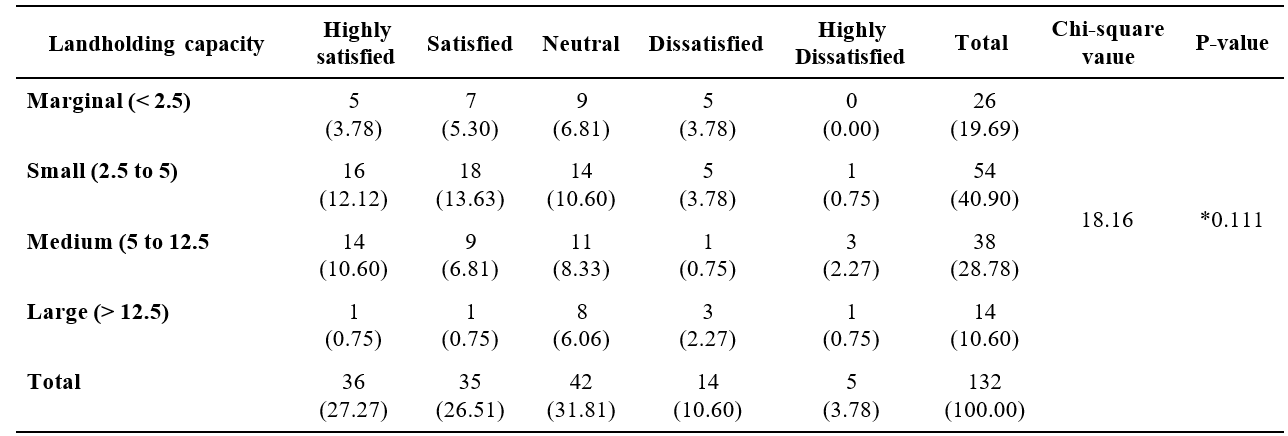Buying Behaviour and Usage Pattern of Pesticides by Rice Growers in Selected Mandals of Bapatla District of a.p
0 Views
L. KRISHNA PRASAD*, A.V. RAMANA, S. JAFFAR BASHA AND SK. NAFEEZ UMAR
Department of Agribusiness Management, S.V. Agricultural College, ANGRAU, Tirupati-517 502.
ABSTRACT
The goal of the current study, “Buying behaviour and usage pattern of pesticides by rice growers in selected mandals of
Bapatla District of A.P” was to determine farmers buying behaviour, factors influencing their buying behaviour, usage pattern and satisfaction level towards pesticide’s efficiency. Bapatla district in Andhra Pradesh was deliberately chosen for this study on the buying behaviour and usage patterns of pesticides among rice farmers. The district holds a significant position in pesticide consumption and ranks third in the state in terms of area under rice cultivation and rice production. The study focused on mandals with the largest rice acreage, leading to the purposive selection of four mandals: Repalle, Nagaram, Bapatla, and Amruthaluru, all known for their extensive rice cultivation. In each of these villages, rice growers were listed, and 11 farmers from each village were randomly selected for the survey, bringing the total sample size to 132 farmers. Data for this study were gathered through a survey method, with interviews conducted using structured interview schedules. The study pertains to the agricultural year 2023- 2024. Majority of sample farmers (65.91%) were falling in the young age group., Education status revealed that majority 25.76 per cent of sample farmers had secondary education. Income revealed that 50 per cent of the sample farmers majorly had income level between ` 100000 to ` 300000. Majority of sample farmers (40.91%) were small farmers with an acreage of 2.5 to 5 acres. Larger proportion of farmers (37.12%) had high farming xii experience of more than 20 years. Majority of farmers (59.09%) preferred to buy pesticides using credit. Over half of the farmers preferred consulting input dealers for farming-related advice. Farmers’ buying decisions are primarily influenced by financial aspects and personal experience, with external demonstrations and official recommendations having a minor role. Chi-square test results show no significant relationship between demographic factors and satisfaction with pesticide aspects. Farmers heavily depend on chemical pesticides for weed, pest, and fungal disease management, using specific herbicides, insecticides, and fungicides. Satisfaction exists with pesticide variety and dealer support, but dissatisfaction is noted with agricultural department services, high credit interest rates, and private dealer prices. Identified issues include untimely supplies and lack of preferred brands from the agricultural department..
KEYWORDS: Buying behaviour, Usage pattern, satisfaction levels.
INTRODUCTION
Agriculture is responsible for providing sustenance to up to 58 per cent of India’s population. Furthermore, the agricultural sector and its allied industries contribute substantially to the nation’s Gross Domestic Product (GDP), accounting for 18.30 percent during the year
2023-2024. Insecticides, herbicides, rodenticides, nematicides, and fungicides are a diverse range of pesticides utilized in agronomic practices to manage pests, weeds, and plant diseases effectively. This research aims to analyze the Buying Behaviour and usage pattern of pesticides by rice growers in selected mandals of the Bapatla District of A.P . Based on various factors that influence pesticide Dealers’ recommendations, Experience, Credit, Price, Influence of neighbour farmers, Availability of required pesticides, Brand image, Field Demonstrations, Discounts, Recommended agriculture department that influence farmers decisions while choosing pesticides. Factors such as price, availability, dealer influence, peer recommendations, brand image, and past experiences were examined to understand the driving forces behind brand selection. The research will investigate the usage pattern of pesticides by rice growers, as it plays a crucial role in pests and disease control.
MATERIAL AND METHODS
Bapatla district in Andhra Pradesh was deliberately chosen for this study on the buying behavior and usage patterns of pesticides among rice farmers. The district holds a significant position in pesticide consumption and ranks third in the state in terms of area under paddy cultivation and paddy production. The study focused on mandals with the largest rice acreage, leading to the purposive selection of four mandals: Repalle, Nagaram, Bapatla, and Amruthaluru, all known for their extensive rice cultivation.
From these selected mandals, all villages with the highest rice acreage were listed. The top three villages from each mandal were then purposively chosen, resulting in a total of 12 villages: Uppudi, Nalluripalem, and Peteru from Repalle; Sajjavaripalem, Manthripalem, and Edupalli from Nagaram; Bapatla, Appikatla, and Nandirajuthota from Bapatla; and Govada, Inturu, and Pedhapudi from Amruthaluru. In each of these villages, rice growers were listed, and 11 farmers from each village were randomly selected for the survey, bringing the total sample size to 132 farmers. Data for this study were gathered through a survey method, with interviews conducted using structured interview schedules. The study pertains to the agricultural year 2023-2024.
The primary data regarding the socio-economic profile of sample farmers, farmers pesticide buying behaviour, factors influencing buying behaviour of farmers towards pesticides, Usage pattern of pesticides by sample farmers and satisfaction level towards pesticides availability, price, control over pests and diseases and it’s ease of application were collected using an interview schedule. The data collected were subjected to the appropriate set of statistical tools to arrive at valid conclusions. Collected data was statistically analyzed using SPSS program, frequencies percentages, mean, percentages and Garret’s ranking technique. This approach provided a detailed and nuanced understanding of the dataset.
RESULTS AND DISCUSSION
Factors influencing buying behaviour of farmers
Project examined the sources of information on the factors on Table.1 were Dealers recommendation, Experience, Credit, Price, Influence of neighbour farmers, Availability of required pesticide, Brand image, Field Demonstrations, Discounts, Recommended agriculture department. The farmer’s preference for pesticides is influenced by mostly dealers’ influence (Garrett mean score of 75.37), Experience (Garrett mean score of 766.02), Credit (Garrett mean score of 60.63), Price (Garrett mean score of 54.18), the influence of neighbour farmers (Garrett mean score of 50.68), Availability (Garrett mean score of 48.33), Brand image (Garrett mean score of 43.03), Field Demonstrations (Garrett mean score of 37.08), Discounts (Garrett mean score of 32.56) and Recommendations of agriculture department (Garrett mean score of 29.25). This suggests that while financial aspects and personal experience are major drivers in purchasing decisions, external demonstrations and official recommendations play a relatively minor role (Yaswanth, 2021).
Table 1. Factors influencing buying behaviour of farmers

Table 2. Usage pattern of pesticides

Usage pattern of pesticides by farmers
Based on analysis of the usage pattern of pesticides, among herbicides, Bispyribac Sodium 10 per cent SC is the most prevalent, used by 76.52 per cent of farmers to manage a broad range of weeds. It is followed by Pretilachlor 30 per cent + Pyrazosulfuron ethyl 0.75 per cent WG, utilized by 48.48 per cent of farmers, and Fenoxaprop-p-ethyl 6.9 EC, which 39.39 per cent of farmers use to control grassy weeds. In the category of insecticides, Chlorantraniliprole 18.5 per cent W/W SC is the most commonly used, with 71.21 per cent of farmers applying it against lepidopteran insects. Triflumezopyrim 10 per cent SC and Dinetofuran 15 per cent + Pymetrozine 45 per cent WG are used by 40.15 per cent and 34.09 per cent of farmers respectively for managing sucking pests, while Emamectin Benzoate 5 per cent SG is employed by 39.39 per cent of farmers to target lepidopteran insects.(Brar et al., 2018)
For fungicides, Carbendazim 12 per cent + Mancozeb 63 per cent WP is the most widely used, with 58.33 per cent of farmers applying it to combat leaf blast. Hexaconazole 5 per cent SC is also popular, used by 50 per cent of farmers to control sheath blight, and Mancozeb 75 per cent WP is used by 32.58 per cent of farmers for leaf blast management (Deviprasad et al., 2015)
Kasugamycin 3 per cent SL, utilized by 13.64 per cent of farmers, is the primary bactericide for managing bacterial leaf blight. The data indicates a significant dependence on chemical pesticides among farmers. Herbicides like Bispyribac Sodium and Pretilachlor are crucial for effective weed management. Insecticides such as Chlorantraniliprole and Emamectin Benzoate are essential for pest control, while fungicides, particularly Carbendazim and Hexaconazole, highlight the prevalent issue of fungal diseases. Although bactericides are less commonly used, they remain important for addressing bacterial infections in crops.(Radadiya et al.,2021)
Satisfaction levels of farmers towards pest and disease control while using pesticide
Age Vs Satisfaction level towards control over Pests & diseases by Sample Farmers.
According to Table 3, out of the 132 sample farmers, the largest proportion (65.91%) belonged to the old age group (above 50 years), followed by 21.21% who were categorized as middle-aged (31-50 years), and 12.37 per cent who fell into the young age group (up to 30 years). 29 out of the 132 farmers (i.e. 21.96%) belongs to middle age category who are neutral towards pest and disease control. These are the highest values and percentages in the Table 3. The chi- square value is 6.545 and p-value for the Pearson Chi-Square test is greater than 0.05, indicating a statistically no significant association between their age group and satisfaction levels towards pest and disease control. The findings indicate that age does not have a significant influence on farmers’ satisfaction with pest and disease control. Despite differences in responses across age groups, statistical analysis shows no strong association.(Parmar et al., 2020)
Education level Vs Satisfaction level towards control over Pests and diseases by Sample Farmers.
A review of Table 4 reveals that 13.64 per cent of the farmers were illiterate, 6.06 per cent were functionally literate, 18.18 per cent had completed intermediate education and 11.36 per cent held a degree or higher. 14 out of the 132 farmers (i.e. 10.60%) have secondary education who are neutral towards pest and disease control These are the highest values and percentages in the Table
The chi-square value is 24.55 and p-value for the Pearson Chi- Square test is greater than 0.05, indicating a statistically no significant association between their education levels and satisfaction levels towards pest and disease control. The analysis suggests that education level does not significantly impact farmers’ satisfaction with pest and disease control measures. While variations exist, statistical results indicate no strong association between education and satisfaction levels (Yadav et al., 2019).
Operational land holding Vs Satisfaction level towards control over Pests and diseases by Sample Farmers.
Table 5 indicates that among the sample farmers, 19.7 per cent were marginal farmers. Small farmers made up 40.91 per cent while medium farmers accounted for 28.79 per cent. 14 out of the 132 farmers (i.e. 10.60%) are medium farmers who are highly satisfied towards pest and disease control. These are the highest values and percentages in the Table 5. The chi-square value is 18.16 and p-value for the Pearson Chi-Square test is greater than 0.05, indicating a statistically no significant association between size of landholding and satisfaction levels towards pest and disease control. The findings suggest that farm size does not significantly influence farmers’ satisfaction with pest and disease control
Table 3. Age vs Satisfaction level towards control over Pests & diseases by Sample Farmers

Table 4. Education level Vs Satisfaction level towards control over Pests and diseases by Sample Farmers

Table 5. Operational land holding Vs Satisfaction level towards control over Pests and diseases by Sample Farmers

Table 6. Operational land holding Vs Satisfaction level towards control over Pests and diseases by Sample Farmers

measures. Despite variations in satisfaction levels across different landholding categories, statistical analysis indicates no strong association.(Mahentesh et al., 2009)
Income levels Vs Satisfaction level towards control of Pesticides by Sample Farmers
Table 6 shows that 30.3 per cent of the farmers fell into the low-income group, 50 per cent were in the medium-income group, and 19.69 per cent belonged to the high-income groups. 23 out of the 132 farmers (i.e. 17.42%) are medium income farmers who are highly satisfied towards pest and disease control. These are the highest values and percentages in the Table 6. The chi- square value is 11.99 and p-value for the Pearson Chi- Square test is greater than 0.05, indicating a statistically no significant association between their income levels and satisfaction levels towards pest and disease control. This means that differences in farmers income levels are not significantly related to differences in satisfaction levels towards pest and disease control.
LITERATURE CITED
Brar, G.S., Patyal, S.K., Dubey, J.K and Singh, G. 2018. Survey on pesticide use pattern and farmers perceptions in cauliflower and brinjal growing areas in three districts of Himachal Pradesh, India. International Journal of Current Microbiology and Applied Sciences. 7(03): 2417-2423.
Deviprasad, A.G., Radha, S. and Manonmani, H.K., 2015. Pesticide usage pattern in four districts of Karnataka: A survey. IOSR J. Environ. Sci. Toxicol. Food Technol. 9: 48-51.
Mahantesh, N and Singh, A. 2009. A study on farmers’ knowledge, perception and intensity of pesticide use in vegetable cultivation in Western Uttar Pradesh, (Indian Agricultural Research Institute).
Parmar, P., Lakhlani, C.D and Trivedi, S.M 2020. Consumer behavior and satisfaction level towards herbicide in Gujarat state. Journal of Pharmacognosy and Phytochemistry. 9(3): 2058-2061.
Radadiya, H.R. 2021. Awareness and satisfaction among the users of glyzeel herbicide in Gir- Somnath district. MBA (Agri-Business). Master Thesis (Unpublished). Junagadh Agricultural University, Junagadh.
Yadav, S and Dutta, S. 2019. A study of pesticide consumption pattern and farmer’s perceptions towards pesticides: A case of Tijara Tehsil, Alwar (Rajasthan). International Journal of Current Microbiology and Applied Sciences. 8(4): 96-104.
Yaswanth, C. 2021. Buying behaviour of farmers towards pesticides in kurnool district of Andhra Pradesh (Ph.D) Thesis, Acharya N.G. Ranga Agricultural University.
- Production Potential of Sweet Corn as Influenced by Organic Manures and Foliar Nutrition
- Characterization of Grain Iron and Zinc Content in Little Millet Genotypes
- Faunistic Studies on Economically Important Lepidopterans in Different Field Crops of Tirupati District
- An Annotated Checklist of Cyperceae, Eriocaulaceae and Potamogetonaceae of Chhattisgarh
- Genetic Divergence Studies for Yield, Yield Components and Resistance to Late Leaf Spot in Groundnut (Arachis Hypogaea L.)
- Effect of Organic Farming on Soil Enzymatic Activity and Productivity of Groundnut Based Cropping System

